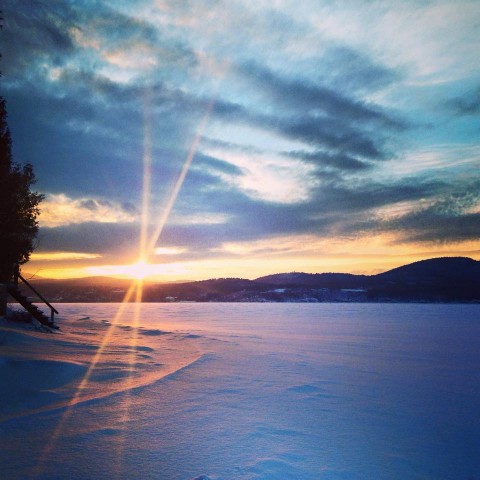The beauty and the chill will invigorate you. Image by Paige Trubatch.
I’ve long said I’ll never pay for a gym membership, so long as I can hike and keep myself healthy in the good ol’ outdoors. Well, last year I joined a gym for a grand total of eight weeks. I soon resolved to try to adhere to my original gut feeling that I’d rather be free to roam, even in the mid-winter depths of a New England winter.
Safety is always first when setting out into the woods, whether for a multi-day backpacking trip or a half-day walk just to get out of the house for a few hours. For the stir-crazy Girl Go, here are some tips to consider before hitting the snowy trail.
Pick What to Wear Wisely
Make sure to wear base layers to insulate and keep you warm, as well as wool socks. I love my REI membership, and I usually find good promotions on store-brand hiking socks that I like to stock up on. And always carry an extra pair! After you step into a puddle that didn’t look “that deep,” or the snow melts its way through your shoes, you’ll never hike without a spare. It’s also an excellent safety precaution, as hiking in wet socks for an extended period of time could potentially turn dangerous.
Pack a Small Safety Kit
Another often overlooked aspect of casual day hiking is the first aid kit. It’s so important to carry a small safety kit and to know how to use everything in it. You can get certainly get creative with wilderness first aid, and it’s empowering to know you could care for yourself and your loved ones should the unexpected occur.
Fear not, however; wilderness first aid doesn’t have to be scary! Splints can be fashioned from most items you’ll have in your pack anyway, as evidenced by the splint fashion show that concluded my NOLS Wilderness First Aid course.
Your kit also doesn’t have to be bulky. It’s okay to have a stockpile of different items for your kit and then add or subtract appropriate items for any given hike/day.
Choose an Alternative Trail
When challenging trails may be “off limits” due to ice or snow coverage, consider walking more even-terrain trails along historical routes or near other cultural landmarks. You still get the refreshing chill and the scent of crisp winter air in the outdoors, but with less risk of avoidable injury.
With a little research, you can find some pretty amazing historical and cultural landmarks to explore along gentle walking trails in the woods. As an American history geek, I love how different regions reflect our country’s coming-of-age. It’s when you’re trekking along a snow-covered path with birds overhead, very aware of each step and the snowy crunch underfoot, that you begin to empathize with generations of earlier Americans who built lives and fought wars in these very woods.

Nerding out on the trail one snowy Saturday. Image by Paige Trubatch.
In my own locale of Bear Mountain and Harriman State Park, there are tons of Colonial-era points of interest. You can even explore the remnants of Doodletown, an isolated hamlet that was settled in the 1760s and completely abandoned by the 1960s, along a trail with educational plaques detailing the history of what once stood upon the foundations left behind.
One of life’s simplest great pleasures, a cold beer in a warm tavern, has never gone out of style. The ’76 House in nearby Tappan, NY has a long and fascinating history as a cozy watering hole and Revolutionary headquarters, also serving as the temporary prison for Benedict Arnold’s co-conspirator, Major John Andre. But unlike Andre, you’re free to leave after your post-hike refreshment.
I’d recommend finding a cozy couch, in this century, to rest up before your next woodland excursion. And when you return inside from the brisk woodland air, you can kick off your boots and relax by the fire, feeling alive and good as you warm your bones.
 Sunsets aren’t so bad when you’ve got a chill in your bones! Image by Paige Trubatch.
Sunsets aren’t so bad when you’ve got a chill in your bones! Image by Paige Trubatch.
